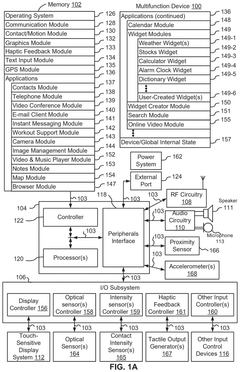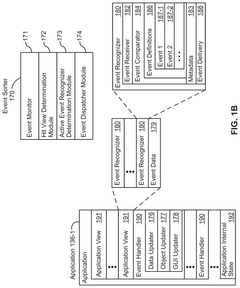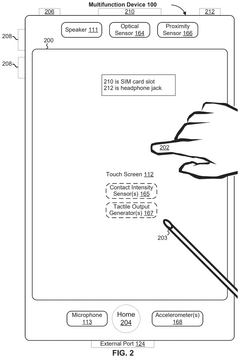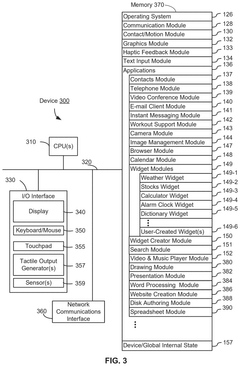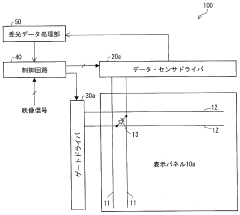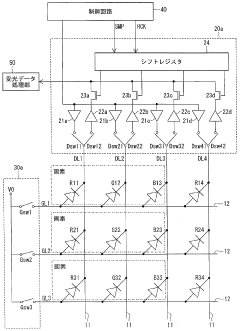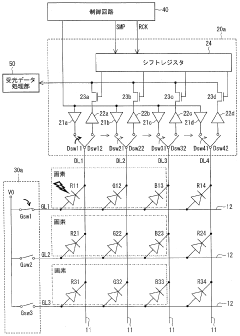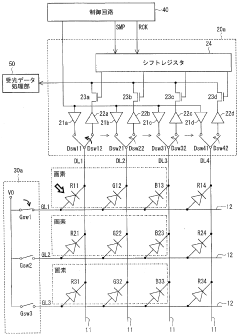Enhancing User Experience with ULED Interfaces
JUN 23, 20259 MIN READ
Generate Your Research Report Instantly with AI Agent
Patsnap Eureka helps you evaluate technical feasibility & market potential.
ULED Interface Evolution
The evolution of ULED (Ultra-Light Emitting Diode) interfaces represents a significant leap in display technology, marking a transformative journey in enhancing user experience. This progression can be traced through several key developmental stages, each characterized by notable technological advancements and innovative solutions.
In the early phases, ULED technology emerged as a promising alternative to traditional LED and OLED displays. The initial focus was on improving brightness and energy efficiency, with researchers and engineers striving to overcome the limitations of existing display technologies. This period saw the development of fundamental ULED structures and the exploration of various materials to optimize light emission.
As the technology matured, attention shifted towards enhancing color reproduction and contrast ratios. This stage witnessed the introduction of quantum dot technology in ULED displays, dramatically expanding the color gamut and improving overall picture quality. Concurrently, efforts were made to refine the manufacturing processes, gradually making ULED displays more cost-effective and suitable for mass production.
The next significant milestone in ULED interface evolution was the pursuit of higher refresh rates and reduced response times. This development was particularly crucial for improving the user experience in fast-paced applications such as gaming and virtual reality. Engineers focused on optimizing the electron mobility within ULED structures, resulting in displays capable of ultra-high refresh rates and near-instantaneous pixel transitions.
Recent years have seen a strong emphasis on flexibility and form factor innovation. Researchers have been working on developing flexible ULED displays that can be bent, folded, or rolled without compromising image quality. This advancement has opened up new possibilities for device design and user interaction, paving the way for foldable smartphones, rollable televisions, and wearable displays.
The latest frontier in ULED interface evolution is the integration of advanced sensing technologies. Current research is focused on incorporating touch sensitivity, pressure detection, and even biometric sensors directly into the display layer. This integration aims to create more intuitive and responsive user interfaces, blurring the lines between display and input technologies.
Throughout this evolutionary journey, a consistent thread has been the drive towards improved energy efficiency. Each generation of ULED technology has sought to deliver enhanced visual performance while reducing power consumption, aligning with the growing emphasis on sustainability in consumer electronics.
In the early phases, ULED technology emerged as a promising alternative to traditional LED and OLED displays. The initial focus was on improving brightness and energy efficiency, with researchers and engineers striving to overcome the limitations of existing display technologies. This period saw the development of fundamental ULED structures and the exploration of various materials to optimize light emission.
As the technology matured, attention shifted towards enhancing color reproduction and contrast ratios. This stage witnessed the introduction of quantum dot technology in ULED displays, dramatically expanding the color gamut and improving overall picture quality. Concurrently, efforts were made to refine the manufacturing processes, gradually making ULED displays more cost-effective and suitable for mass production.
The next significant milestone in ULED interface evolution was the pursuit of higher refresh rates and reduced response times. This development was particularly crucial for improving the user experience in fast-paced applications such as gaming and virtual reality. Engineers focused on optimizing the electron mobility within ULED structures, resulting in displays capable of ultra-high refresh rates and near-instantaneous pixel transitions.
Recent years have seen a strong emphasis on flexibility and form factor innovation. Researchers have been working on developing flexible ULED displays that can be bent, folded, or rolled without compromising image quality. This advancement has opened up new possibilities for device design and user interaction, paving the way for foldable smartphones, rollable televisions, and wearable displays.
The latest frontier in ULED interface evolution is the integration of advanced sensing technologies. Current research is focused on incorporating touch sensitivity, pressure detection, and even biometric sensors directly into the display layer. This integration aims to create more intuitive and responsive user interfaces, blurring the lines between display and input technologies.
Throughout this evolutionary journey, a consistent thread has been the drive towards improved energy efficiency. Each generation of ULED technology has sought to deliver enhanced visual performance while reducing power consumption, aligning with the growing emphasis on sustainability in consumer electronics.
UX Market Demand Analysis
The market demand for enhanced user experiences through ULED (Ultra Light Emitting Diode) interfaces has been growing rapidly in recent years. This surge is driven by the increasing consumer expectations for more immersive, responsive, and visually appealing digital interactions across various devices and platforms.
ULED technology offers significant advantages over traditional display technologies, including higher brightness, better contrast ratios, and improved energy efficiency. These features directly translate to superior user experiences, making ULED interfaces highly desirable in both consumer electronics and professional applications.
In the consumer electronics sector, smartphones, tablets, and smart home devices are at the forefront of ULED interface adoption. Users are increasingly seeking devices with vibrant, high-resolution displays that can deliver crisp visuals even in challenging lighting conditions. The automotive industry is also showing strong interest in ULED interfaces for in-vehicle infotainment systems and digital dashboards, as they offer enhanced readability and aesthetics.
The professional market segment, including fields such as medical imaging, digital signage, and high-end monitors for creative professionals, is another area where ULED interfaces are in high demand. These sectors require displays with exceptional color accuracy, high refresh rates, and consistent performance over extended periods.
Market research indicates that the global ULED display market is expected to grow significantly over the next five years. This growth is fueled by advancements in ULED manufacturing technologies, which are making these displays more cost-effective and accessible to a broader range of products and applications.
User experience designers and product developers are particularly interested in ULED interfaces due to their potential to create more engaging and intuitive user interfaces. The technology's ability to produce deeper blacks and more vibrant colors allows for the creation of visually striking UI elements that can guide user attention more effectively and enhance overall usability.
Moreover, the reduced power consumption of ULED displays compared to traditional LED or OLED screens is aligning well with the growing consumer demand for more environmentally friendly and energy-efficient devices. This aspect is becoming increasingly important in purchasing decisions, especially for mobile devices where battery life is a critical factor.
As the Internet of Things (IoT) continues to expand, there is a rising demand for ULED interfaces in smart home devices, wearables, and other connected gadgets. These applications benefit from ULED's ability to deliver clear, readable information on small screens while maintaining long battery life.
In conclusion, the market demand for enhanced user experiences through ULED interfaces is robust and multifaceted. It spans across various industries and is driven by both technological advancements and evolving consumer expectations. As ULED technology continues to mature and become more accessible, its adoption is expected to accelerate, further transforming the landscape of digital interfaces and user experiences.
ULED technology offers significant advantages over traditional display technologies, including higher brightness, better contrast ratios, and improved energy efficiency. These features directly translate to superior user experiences, making ULED interfaces highly desirable in both consumer electronics and professional applications.
In the consumer electronics sector, smartphones, tablets, and smart home devices are at the forefront of ULED interface adoption. Users are increasingly seeking devices with vibrant, high-resolution displays that can deliver crisp visuals even in challenging lighting conditions. The automotive industry is also showing strong interest in ULED interfaces for in-vehicle infotainment systems and digital dashboards, as they offer enhanced readability and aesthetics.
The professional market segment, including fields such as medical imaging, digital signage, and high-end monitors for creative professionals, is another area where ULED interfaces are in high demand. These sectors require displays with exceptional color accuracy, high refresh rates, and consistent performance over extended periods.
Market research indicates that the global ULED display market is expected to grow significantly over the next five years. This growth is fueled by advancements in ULED manufacturing technologies, which are making these displays more cost-effective and accessible to a broader range of products and applications.
User experience designers and product developers are particularly interested in ULED interfaces due to their potential to create more engaging and intuitive user interfaces. The technology's ability to produce deeper blacks and more vibrant colors allows for the creation of visually striking UI elements that can guide user attention more effectively and enhance overall usability.
Moreover, the reduced power consumption of ULED displays compared to traditional LED or OLED screens is aligning well with the growing consumer demand for more environmentally friendly and energy-efficient devices. This aspect is becoming increasingly important in purchasing decisions, especially for mobile devices where battery life is a critical factor.
As the Internet of Things (IoT) continues to expand, there is a rising demand for ULED interfaces in smart home devices, wearables, and other connected gadgets. These applications benefit from ULED's ability to deliver clear, readable information on small screens while maintaining long battery life.
In conclusion, the market demand for enhanced user experiences through ULED interfaces is robust and multifaceted. It spans across various industries and is driven by both technological advancements and evolving consumer expectations. As ULED technology continues to mature and become more accessible, its adoption is expected to accelerate, further transforming the landscape of digital interfaces and user experiences.
ULED Tech Challenges
ULED (Ultra Light Emitting Diode) technology presents several significant challenges in its development and implementation for enhancing user interfaces. One of the primary obstacles is achieving consistent and uniform light distribution across the display surface. Unlike traditional LED displays, ULED interfaces require extremely precise control over each individual diode to maintain color accuracy and brightness uniformity, especially at lower brightness levels.
Another major challenge lies in the miniaturization of ULED components. As user interfaces demand higher resolutions and pixel densities, manufacturers must develop ways to produce and integrate increasingly smaller ULED elements without compromising performance or reliability. This miniaturization process also impacts heat management, as smaller components are more susceptible to thermal issues that can affect both performance and lifespan.
Power efficiency remains a critical concern in ULED technology. While ULEDs are generally more energy-efficient than traditional LEDs, further improvements are necessary to meet the stringent power requirements of mobile and wearable devices. Balancing power consumption with brightness and color accuracy is an ongoing challenge that requires innovative circuit designs and power management strategies.
The manufacturing process for ULED displays presents its own set of challenges. Achieving high yields in the production of these complex, high-precision components is difficult and costly. Developing scalable manufacturing techniques that can produce ULEDs at a competitive price point is crucial for widespread adoption in consumer electronics.
Color management and calibration pose significant technical hurdles for ULED interfaces. Ensuring accurate color reproduction across a wide gamut, while maintaining consistency over time and under various environmental conditions, requires sophisticated algorithms and sensor technologies. This challenge is particularly acute in applications that demand high color fidelity, such as professional design tools or medical imaging displays.
Durability and longevity of ULED displays are also areas of concern. As these interfaces are integrated into a wider range of devices, including those exposed to harsh environments or frequent use, ensuring the long-term stability of ULED components becomes crucial. Addressing issues such as color shift, brightness degradation, and physical wear over time is essential for maintaining user satisfaction and device longevity.
Lastly, the integration of ULED technology with other emerging interface technologies, such as touch sensors, haptic feedback systems, and flexible or foldable displays, presents complex engineering challenges. Developing seamless, multi-modal interfaces that leverage the unique properties of ULEDs while accommodating these complementary technologies requires interdisciplinary research and development efforts.
Another major challenge lies in the miniaturization of ULED components. As user interfaces demand higher resolutions and pixel densities, manufacturers must develop ways to produce and integrate increasingly smaller ULED elements without compromising performance or reliability. This miniaturization process also impacts heat management, as smaller components are more susceptible to thermal issues that can affect both performance and lifespan.
Power efficiency remains a critical concern in ULED technology. While ULEDs are generally more energy-efficient than traditional LEDs, further improvements are necessary to meet the stringent power requirements of mobile and wearable devices. Balancing power consumption with brightness and color accuracy is an ongoing challenge that requires innovative circuit designs and power management strategies.
The manufacturing process for ULED displays presents its own set of challenges. Achieving high yields in the production of these complex, high-precision components is difficult and costly. Developing scalable manufacturing techniques that can produce ULEDs at a competitive price point is crucial for widespread adoption in consumer electronics.
Color management and calibration pose significant technical hurdles for ULED interfaces. Ensuring accurate color reproduction across a wide gamut, while maintaining consistency over time and under various environmental conditions, requires sophisticated algorithms and sensor technologies. This challenge is particularly acute in applications that demand high color fidelity, such as professional design tools or medical imaging displays.
Durability and longevity of ULED displays are also areas of concern. As these interfaces are integrated into a wider range of devices, including those exposed to harsh environments or frequent use, ensuring the long-term stability of ULED components becomes crucial. Addressing issues such as color shift, brightness degradation, and physical wear over time is essential for maintaining user satisfaction and device longevity.
Lastly, the integration of ULED technology with other emerging interface technologies, such as touch sensors, haptic feedback systems, and flexible or foldable displays, presents complex engineering challenges. Developing seamless, multi-modal interfaces that leverage the unique properties of ULEDs while accommodating these complementary technologies requires interdisciplinary research and development efforts.
Current ULED UX Solutions
01 User interface customization for ULED displays
ULED interfaces can be customized to enhance user experience. This includes adjustable layouts, personalized themes, and adaptive color schemes that respond to user preferences and environmental conditions. Such customization allows for a more intuitive and comfortable viewing experience across various applications and device types.- User interface customization for ULED displays: ULED interfaces can be customized to enhance user experience. This includes adjustable layouts, personalized themes, and adaptive content presentation based on user preferences and behavior. The customization allows for a more intuitive and efficient interaction with the ULED display, improving overall user satisfaction.
- Gesture and touch-based interactions for ULED displays: Implementing gesture recognition and touch-based controls in ULED interfaces can significantly improve user experience. These interaction methods allow for more natural and intuitive navigation, reducing the learning curve for users and enabling quicker access to features and content.
- AI-powered content recommendations and interface adaptation: Artificial intelligence can be integrated into ULED interfaces to provide personalized content recommendations and adapt the interface based on user behavior. This technology can analyze user preferences, viewing habits, and interaction patterns to offer a more tailored and engaging experience.
- Multi-device synchronization and continuity: ULED interfaces can be designed to support seamless synchronization and continuity across multiple devices. This feature allows users to start an activity on one device and continue it on another, providing a cohesive and uninterrupted experience across different ULED-enabled platforms.
- Accessibility features for diverse user needs: Incorporating accessibility features in ULED interfaces ensures a better user experience for individuals with diverse needs. This includes adjustable text sizes, color contrast options, voice commands, and screen readers, making the interface more inclusive and usable for a wider range of users.
02 Gesture and touch-based interactions for ULED interfaces
Advanced gesture recognition and touch-based controls are implemented in ULED interfaces to improve user interaction. These features enable intuitive navigation, seamless content manipulation, and quick access to functions, enhancing overall usability and reducing the learning curve for new users.Expand Specific Solutions03 Integration of AI and machine learning in ULED user experiences
Artificial intelligence and machine learning algorithms are incorporated into ULED interfaces to provide personalized and context-aware experiences. These technologies can predict user preferences, automate routine tasks, and optimize display settings based on usage patterns and environmental factors.Expand Specific Solutions04 Multi-device synchronization and continuity for ULED interfaces
ULED interface designs focus on seamless integration and synchronization across multiple devices. This allows users to start tasks on one device and continue on another, maintaining a consistent experience and interface across different screen sizes and form factors.Expand Specific Solutions05 Accessibility features in ULED interface design
ULED interfaces incorporate advanced accessibility features to cater to users with diverse needs. This includes adjustable contrast ratios, text-to-speech capabilities, color correction modes, and customizable input methods to ensure an inclusive user experience for all individuals.Expand Specific Solutions
ULED Industry Players
The ULED interface technology market is in a growth phase, with increasing adoption across consumer electronics and display industries. The market size is expanding rapidly, driven by demand for enhanced user experiences in smartphones, TVs, and other devices. Technologically, ULED interfaces are maturing, with major players like Apple, Samsung, and LG Display leading innovation. These companies, along with Sony and Sharp, are investing heavily in R&D to improve ULED performance and efficiency. Emerging players such as Visionox and Huawei are also making significant strides, particularly in the Chinese market. The competitive landscape is characterized by intense rivalry among established tech giants and innovative startups, all vying to differentiate their products through superior ULED interface technologies.
Apple, Inc.
Technical Solution: Apple's approach to enhancing user experience with ULED interfaces focuses on integrating their proprietary Liquid Retina XDR display technology. This technology utilizes mini-LED backlighting with local dimming zones, allowing for precise control over brightness and contrast. The display can achieve high peak brightness levels while maintaining deep blacks, resulting in a high dynamic range. Apple combines this hardware innovation with advanced software algorithms for color management and content optimization, ensuring that the ULED interface delivers vivid, accurate colors and smooth motion across various applications.
Strengths: Exceptional image quality, high contrast ratio, and color accuracy. Seamless integration with Apple's ecosystem. Weaknesses: Higher cost compared to traditional LED displays, potential for blooming effects in high-contrast scenes.
Samsung Electronics Co., Ltd.
Technical Solution: Samsung's ULED interface enhancement strategy revolves around their Quantum Dot OLED (QD-OLED) technology. This innovative approach combines the benefits of OLED's self-emissive pixels with quantum dot color conversion. The result is a display that offers perfect blacks, wide viewing angles, and exceptionally vibrant colors. Samsung's implementation includes advanced AI-powered upscaling algorithms to enhance lower resolution content, and variable refresh rate technology for smoother motion in gaming and video playback. Additionally, Samsung incorporates eye comfort features such as blue light reduction and automatic brightness adjustment based on ambient lighting conditions.
Strengths: Superior color volume and brightness compared to traditional OLED, energy efficiency, and wide color gamut. Weaknesses: Production complexity leading to higher costs, potential for burn-in over extended use.
ULED UX Innovations
User interfaces for viewing and accessing content on an electronic device
PatentPendingUS20250138725A1
Innovation
- The development of user interfaces that present representations of items of content available for playback, along with selectable options for accessing content, enhanced previews, control panels, user profile switching, and picture-in-picture modes, aimed at improving user interaction efficiency and experience.
Display device
PatentWO2012036123A1
Innovation
- Incorporating light-emitting diodes (LEDs) with a light-receiving function, allowing them to detect external inputs such as touch, enabling both image display and user interface functionalities within a simple configuration, eliminating the need for a separate detection circuit.
ULED Power Efficiency
ULED (Ultra-Light Emitting Diode) technology has made significant strides in power efficiency, positioning itself as a promising solution for next-generation display interfaces. The power efficiency of ULED displays is a critical factor in enhancing user experience, particularly in mobile and wearable devices where battery life is paramount.
ULED displays achieve superior power efficiency through several key innovations. Firstly, the use of ultra-thin semiconductor layers allows for more efficient electron-hole recombination, resulting in higher light output per unit of power input. This is complemented by advanced pixel architectures that minimize current leakage and improve overall energy utilization.
Another significant contributor to ULED power efficiency is the implementation of local dimming techniques. By selectively controlling the brightness of individual pixels or zones, ULED displays can achieve deeper blacks and higher contrast ratios while simultaneously reducing power consumption. This dynamic power management ensures that energy is only expended where and when it is needed, leading to substantial power savings in real-world usage scenarios.
The incorporation of advanced materials, such as quantum dots, further enhances ULED power efficiency. These nanoscale semiconductors can be tuned to emit specific wavelengths of light with high precision, reducing energy loss due to color filtering and improving overall luminous efficacy. This results in brighter displays that require less power to operate, directly translating to improved battery life in portable devices.
ULED power efficiency also benefits from sophisticated driving schemes and control algorithms. Adaptive refresh rates, for instance, allow the display to adjust its update frequency based on the content being displayed, conserving power during static image presentation while maintaining smooth motion for dynamic content. Similarly, content-aware brightness adjustment algorithms optimize power consumption by fine-tuning display luminance based on ambient lighting conditions and user preferences.
The cumulative effect of these power-saving technologies is a significant reduction in overall energy consumption compared to traditional LED and OLED displays. This not only extends device battery life but also contributes to reduced heat generation, which in turn can lead to improved device longevity and user comfort.
As ULED technology continues to evolve, ongoing research focuses on further improving power efficiency through novel materials, advanced manufacturing processes, and innovative circuit designs. These developments promise to push the boundaries of display technology, offering users an enhanced visual experience with minimal energy trade-offs.
ULED displays achieve superior power efficiency through several key innovations. Firstly, the use of ultra-thin semiconductor layers allows for more efficient electron-hole recombination, resulting in higher light output per unit of power input. This is complemented by advanced pixel architectures that minimize current leakage and improve overall energy utilization.
Another significant contributor to ULED power efficiency is the implementation of local dimming techniques. By selectively controlling the brightness of individual pixels or zones, ULED displays can achieve deeper blacks and higher contrast ratios while simultaneously reducing power consumption. This dynamic power management ensures that energy is only expended where and when it is needed, leading to substantial power savings in real-world usage scenarios.
The incorporation of advanced materials, such as quantum dots, further enhances ULED power efficiency. These nanoscale semiconductors can be tuned to emit specific wavelengths of light with high precision, reducing energy loss due to color filtering and improving overall luminous efficacy. This results in brighter displays that require less power to operate, directly translating to improved battery life in portable devices.
ULED power efficiency also benefits from sophisticated driving schemes and control algorithms. Adaptive refresh rates, for instance, allow the display to adjust its update frequency based on the content being displayed, conserving power during static image presentation while maintaining smooth motion for dynamic content. Similarly, content-aware brightness adjustment algorithms optimize power consumption by fine-tuning display luminance based on ambient lighting conditions and user preferences.
The cumulative effect of these power-saving technologies is a significant reduction in overall energy consumption compared to traditional LED and OLED displays. This not only extends device battery life but also contributes to reduced heat generation, which in turn can lead to improved device longevity and user comfort.
As ULED technology continues to evolve, ongoing research focuses on further improving power efficiency through novel materials, advanced manufacturing processes, and innovative circuit designs. These developments promise to push the boundaries of display technology, offering users an enhanced visual experience with minimal energy trade-offs.
ULED Display Standards
ULED display standards play a crucial role in ensuring consistency, quality, and interoperability across various ULED interface implementations. These standards encompass a wide range of specifications, including pixel density, color gamut, brightness levels, and refresh rates, all of which contribute to the overall user experience.
One of the primary ULED display standards is the Ultra-High Definition (UHD) specification, which defines resolution requirements for ULED displays. This standard typically mandates a minimum resolution of 3840x2160 pixels, commonly known as 4K, to deliver sharp and detailed images. Some advanced ULED displays even support 8K resolution, offering an unprecedented level of visual clarity.
Color accuracy and range are also critical aspects of ULED display standards. The widely adopted DCI-P3 color space is often used as a benchmark, requiring ULED displays to reproduce at least 90% of this color gamut. This ensures vibrant and lifelike color reproduction, enhancing the overall visual experience for users.
High Dynamic Range (HDR) is another key component of ULED display standards. HDR10 and Dolby Vision are two prominent HDR formats that ULED displays often support. These standards define parameters for contrast ratio, peak brightness, and color depth, allowing for more realistic and immersive visual content.
Refresh rate standards for ULED displays have also evolved to meet the demands of modern applications. While 60Hz remains common, many ULED displays now support higher refresh rates of 120Hz or even 240Hz. These higher refresh rates contribute to smoother motion rendering and reduced motion blur, particularly beneficial for gaming and fast-paced content.
Response time is another critical factor addressed in ULED display standards. Many specifications call for response times of 5ms or less, with some high-end displays achieving sub-1ms response times. This rapid pixel transition helps eliminate ghosting and motion artifacts, further enhancing the visual experience.
ULED display standards also encompass power efficiency and environmental considerations. Energy Star certification, for instance, sets guidelines for power consumption and standby modes, ensuring that ULED displays meet certain energy efficiency thresholds without compromising performance.
Connectivity standards are equally important in ULED display specifications. HDMI 2.1 and DisplayPort 1.4 are commonly required to support the high bandwidth necessary for 4K and 8K resolutions at high refresh rates. These standards also enable features like variable refresh rate (VRR) and auto low-latency mode (ALLM), further enhancing the user experience, particularly for gaming applications.
One of the primary ULED display standards is the Ultra-High Definition (UHD) specification, which defines resolution requirements for ULED displays. This standard typically mandates a minimum resolution of 3840x2160 pixels, commonly known as 4K, to deliver sharp and detailed images. Some advanced ULED displays even support 8K resolution, offering an unprecedented level of visual clarity.
Color accuracy and range are also critical aspects of ULED display standards. The widely adopted DCI-P3 color space is often used as a benchmark, requiring ULED displays to reproduce at least 90% of this color gamut. This ensures vibrant and lifelike color reproduction, enhancing the overall visual experience for users.
High Dynamic Range (HDR) is another key component of ULED display standards. HDR10 and Dolby Vision are two prominent HDR formats that ULED displays often support. These standards define parameters for contrast ratio, peak brightness, and color depth, allowing for more realistic and immersive visual content.
Refresh rate standards for ULED displays have also evolved to meet the demands of modern applications. While 60Hz remains common, many ULED displays now support higher refresh rates of 120Hz or even 240Hz. These higher refresh rates contribute to smoother motion rendering and reduced motion blur, particularly beneficial for gaming and fast-paced content.
Response time is another critical factor addressed in ULED display standards. Many specifications call for response times of 5ms or less, with some high-end displays achieving sub-1ms response times. This rapid pixel transition helps eliminate ghosting and motion artifacts, further enhancing the visual experience.
ULED display standards also encompass power efficiency and environmental considerations. Energy Star certification, for instance, sets guidelines for power consumption and standby modes, ensuring that ULED displays meet certain energy efficiency thresholds without compromising performance.
Connectivity standards are equally important in ULED display specifications. HDMI 2.1 and DisplayPort 1.4 are commonly required to support the high bandwidth necessary for 4K and 8K resolutions at high refresh rates. These standards also enable features like variable refresh rate (VRR) and auto low-latency mode (ALLM), further enhancing the user experience, particularly for gaming applications.
Unlock deeper insights with Patsnap Eureka Quick Research — get a full tech report to explore trends and direct your research. Try now!
Generate Your Research Report Instantly with AI Agent
Supercharge your innovation with Patsnap Eureka AI Agent Platform!
